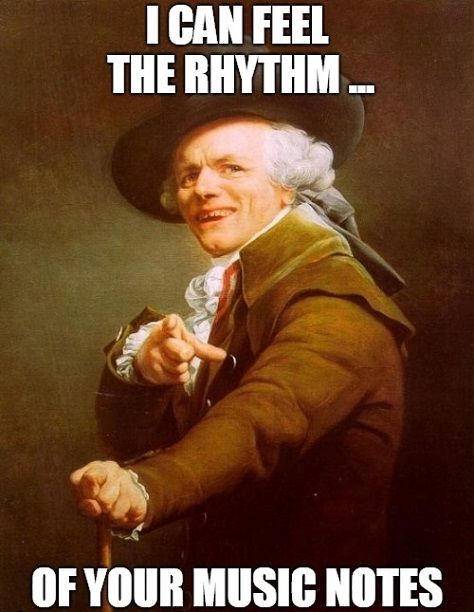Many elements of a song consist of music notes played by an instrument in a certain rhythm. Therefore, it can be useful to know how we can make such a rhythm.
We can make a music note rhythm by playing multiple notes after each other. The note rhythms that make use of portamento need multiple parts of notes pitched above each other.
There are many methods to make a music note rhythm, and this post will explain all the methods I know. Understanding the ‘call and response’ music pattern, which this post will explain first, should help you understand better those methods.
Call and Response Explanation
Call and response is a musical pattern. The pattern is a sequence of two different phrases usually divided over different music parts, by which the ‘call’ is the first phrase, and the ‘response’ is the second phrase. We can hear that the response is a commentary on the call.
There is also a call-and-response pattern in human communication similar to the musical pattern. In many traditions, the musical pattern is a fundamental component of musical form, such as the verse-chorus form (source: Call and response (music)).
To use call and response for music note rhythms, the note rhythm of the response part should be (noticeable) different from the call part rhythm. However, portamento rhythms, which this post will explain below, can also get a different rhythm by using one or more pitches in the call part that are different from the response part of the rhythm.
As far as I know, the musical call-and-response pattern can have one or multiple call parts before one or multiple response parts. When there are multiple call parts, these parts are all the same, and we can see all these same call parts together as one big call part. Also, when there are multiple response parts, these parts are all the same, and we can see all these same response parts together as one big response part.
Methods To Make Music Note Rhythms
People can find music note rhythms important. Therefore it could be a good idea to give such a rhythm some extra attention, which does not mean that we should make it more complicated.
When a music note rhythm becomes more complex, it does not mean that the rhythm becomes better. It can be a good idea to let the complexity of a note rhythm get determined by the complexity of other element rhythms (not only elements with music notes) that are part of the same song. As a guideline, the more complex the rhythm in the other elements are, the more simple the new note rhythm becomes, and vice versa.
When we make a music note rhythm, it can help that we play all the notes on one pitch, so we can only focus on the rhythm. However, portamento rhythms use multiple pitches above each other, which this section explains below.
It might help to have a little understanding of the four-on-the-floor rhythm pattern. As far as I know, this pattern is the most common one in electronic dance music (EDM). Some of the methods below use this pattern.
Four-on-the-floor, also known as four-to-the-floor, is a rhythm pattern utilized primarily in several styles of music, such as disco, house, and techno. The pattern is a constant and evenly emphasized beat in 4/4 time in which someone or something plays the bass drum on every beat (1, 2, 3, and 4) in common time (source: Four on the floor (music)).
In the following methods, the music note lengths don’t matter that much (they are a preference) since these methods are about the starting moments of the notes.
On the Beat Rhythm
An on-the-beat rhythm has one or more notes that start right on the beat. So, when we use a four-on-the-floor rhythm pattern, then the bass drum (kick) starts at the same moment as the notes of the on-the-beat rhythm.
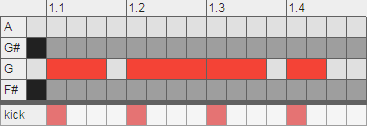
Offbeat Rhythm
We have an offbeat rhythm when we play a music note right in the middle between two beats, which we can also do for other combinations of two beats. For example, when we use a four-on-the-floor rhythm pattern, we can start the notes of the offbeat rhythm all between the start of the kicks.
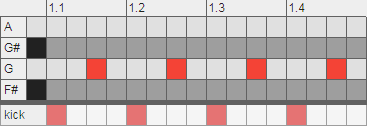
Over the Beat Rhythm
An over-the-beat rhythm has a music note that starts somewhere between two beats, and the note is long enough to go over or stop on a beat. The rhythm can also have such long enough notes between other combinations of two beats. If we use a four-on-the-floor rhythm pattern, then the notes of the over-the-beat rhythm start before the kick plays and end when the kick plays or after that.
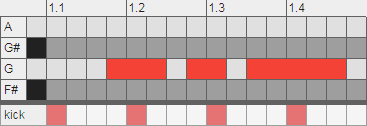
Reuse a Rhythm From Another Element
We can use the same rhythm of a different element of our track for our new music note rhythm. For example, we can use (a part of) the same rhythm of a percussion, melody, or chords we already use in our track.
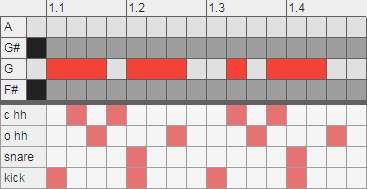
Call and Response Rhythm
As already explained, we can use the musical pattern call and response to make a music note rhythm.
Here follows an example of a two bars long call and response music note rhythm. The first bar of this rhythm is the call part, and the second bar is the response part. The call has longer notes than the response, and there is a noticeable rest between the call and response.

A more subtle example is one of a rhythm with five music notes in one bar. The first four notes are the same length that we can see as four call parts or one big call part. The fifth note is the response part that is an 8th-note shorter than the notes of the call part.
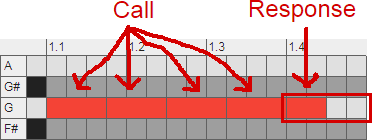
Portamento Rhythm
We can make a portamento music note rhythm when the instrument we use has a portamento option, which many synthesizers have.
A portamento rhythm has at least two parts of music notes pitched above each other. We need such note parts above each other to make it possible that the pitch of a note can slide from one note into another one with a different pitch.
An example of a portamento rhythm would be that we play a 4th-note on G and another 4th-note on D that starts 8th-note later than the first note so that there are two 8th-note parts above each other.
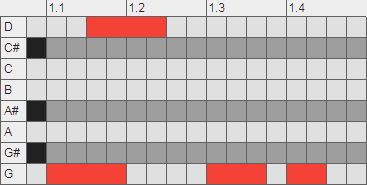
Random Rhythm or Combine Rhythms
The random rhythm method is probably the most creative method by which we can make a music note rhythm.
We can create a note rhythm with the random rhythm method by playing music notes of random lengths at random places and then hope it sounds good. When we don’t like the result of this method, we can repeat this process until we have something we like.
We can make new music note rhythms by combining the already mentioned methods by which we can make such a rhythm. However, combining these methods doesn’t have to result in better rhythms or something like that.
There are probably an endless amount of possibilities with combining methods. However, to make it easier, we can choose for every music note we want in our rhythm a different method.
For example, we want three notes in our rhythm and use a different (already mentioned) music note rhythm method for each of these notes. Then we could use an on-the-beat rhythm for the first note, an over-the-beat rhythm for the first note, and do something random for the third note.
Changing the Length of a Music Note Rhythm
Every rhythm length can be good and usable, but some lengths are at least in (electronic dance music) EDM more common, as far as I know. These common lengths are 1 bar, 2 bars, 4 bars, 8 bars, and 16 bars.
We can use this section’s methods below to make a music note rhythm we already have shorter or longer. We can also combine these methods, which we can do by using one of these methods and then using another one, which we can repeat.
Duplicate Fully or a Part of a Rhythm
When we want to have the length of our music note rhythm doubled, we can duplicate the whole rhythm and play the duplicated rhythm behind the original one. We can do such duplication as much as we want.
We can also duplicate only a part of a music note rhythm to make it longer and place the duplicate after the original part.
For example, we have a rhythm with six notes after each other that we want to change to eight notes.
We can duplicate the third and the fourth note of the rhythm and place the duplicates after the fourth note. So that the duplicate third note becomes the fifth note, and the duplicate fourth note becomes the sixth note. The original fifth note is now the seventh note, and the original sixth note is now the eighth note.
Combining the duplication of a whole music note rhythm and the duplication of only a part of a rhythm can be a good method to make a rhythm longer.

Remove a Part of a Rhythm
When we want to shorten a rhythm, we can do that by removing a part of our music note rhythm, which is the same as removing at least one note from it.
For example, we have a rhythm with six notes after each other that is longer than one bar, which we want to change to four notes so that the length becomes one bar. We can remove two notes somewhere in the rhythm, leading to a possible rest within the rhythm, which we can also remove, making the rhythm shorter.
Add a Call or Response Part to a Rhythm
We can also use the already mentioned call and response music pattern to make a music note rhythm longer. To make an existing rhythm longer with that pattern, we add a call or response part to the rhythm.
First, we have to choose to make the music note rhythm we already have longer by adding something before or after it. If we want to add something before (which is adding the call part), the rhythm we already have is the response part. If we want to add something after (which is adding the response part), the rhythm we already have is the call part.
Here is an example of how we could add a response to an existing music note rhythm. The existing rhythm has an 8th-note rest at the end, which is also the only rest. Behind this rest, we add the response part, which is a similar rhythm as the existing one but with shorter notes and more rests.
As already mentioned, we can have multiple call parts and response parts. For example, we could repeat the rhythm we already have multiple times to get multiple call or response parts. We can also add one or more call or response parts.

Making Music Note Rhythms More Interesting With Velocity
Velocity is the force by which an instrument plays a music note (source: MIDI Velocity: What It Is & How It Works). I would explain velocity as a force by which we can control the audio volume of a note an instrument plays. It could be possible that we have to configure our instrument first to make differences in note velocities hearable.
For example, when I initialize the Sylenth 1 synthesizer by Lennar Digital, the velocity differences between notes are not hearable. However, it is possible to configure Sylenth 1 to hear the velocity differences in audio volume.
It is also possible to configure the Sylenth 1 synthesizer that the velocity differences are differently hearable than audio volume. As an example, these velocity differences can change the cutoff filter (source: Lennar Digital Sylenth 1 Polyphonic VSTi synthesizer User Manual Version 2.5).
With the use of velocity differences, we can make music note rhythms more interesting. We can choose (it is not necessary) to use velocity differences in our rhythms. Velocity differences could make rhythms better (which is an opinion), but that is not the case for all rhythms.
As far as I know, most of the time, people use velocity differences in a music note rhythm for two reasons:
- The first reason is to make the rhythm sound more as a human would play it since humans don’t / can’t play multiple notes after each other perfectly at the same velocity. So, for example, a note rhythm for a piano or guitar could benefit from such a rhythm. Further, computers can play all notes of a rhythm perfectly at the same velocity.
- The second reason is to use the velocity differences creatively to make the rhythms more creative.
The methods in this section below use velocity values ranging from 1 to 100. The value 1 is the lowest possible audio volume, and the value 100 is the highest possible audio volume.
It might be good to know that we can even hear/notice consciously or unconsciously velocity value differences of 1 or 2 between music notes in a rhythm.
Humanize/Randomize a Music Note Rhythm With Velocity
We can humanize a music note rhythm with velocity differences between notes. As far as I know, a common method to do such humanizing of a note rhythm is to play each of the notes at a random velocity within a certain range. Such a velocity value range could be from 80 to 100.
For example, when we have a rhythm with five music notes. We can set the first note on velocity 98, the second note on 93, the third note on 87, the fourth note on 94, and the fifth note on 88.

We can also randomize the velocity of music notes with a MIDI effect/plugin, such as with the Velocity MIDI effect of Ableton Live. There are at least two advantages when we use such a MIDI effect.
The first advantage is that we can play a rhythm with all the music notes on one velocity, and the MIDI effect automatically changes these same velocities to randomized velocities. The second advantage is that the randomized note velocity values can be different each time we play the same rhythm.
Call and Response With Velocity Differences
We can use the already mentioned musical pattern call and response on the velocities of a music note rhythm. Using this pattern on note velocities is probably very creative since I rarely notice it in songs.
It might be good to know that the lengths and placements of the notes we use in the call part can be the same as in the response part since we can use the pattern only on the note velocities.
For example, when we have four times after each other a combination of a note with a rest. We can play the first two notes on the velocity value 70 and the other notes on velocity 100. We could also say that this example has two call parts (the notes on velocity 70) and two response parts (the notes on velocity 100), at least as far as I know.
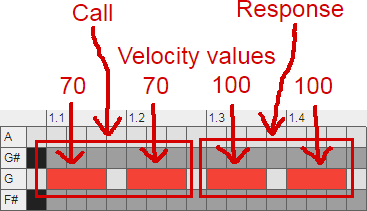
Another example, we have two notes combined with two rests in the call part that are the same as the two notes combined with two rests in the response part. Further, in the call part, we can play the first note on velocity 63 and the second note on velocity 92. In the response part, we can play the first note on velocity 85 and the second note on velocity 71.

We can see this second example also as two call and two response rhythms after each other. The notes on velocity 63 and 85 are the call parts, and the notes on velocity 92 and 71 are the response parts.
When we have a music note on velocity 87, and after this note, there is a note on velocity 88, these two notes are also in a (very subtle) call and response pattern, at least as far as I know.
Combine Velocity Rhythm Methods
We can combine the mentioned velocity methods, which we can do by using one of the two velocity methods and then using another one.
For example, we have a two-bar long music note rhythm with eight notes, with the first four notes in the first bar and the other four notes in the second bar. We could use the call and response method on the first two notes in the first bar and on the first two notes in the second bar. Also, we can use the humanize method on the other four notes, which might not be possible to do with a MIDI effect on only these four notes.
Adding Swing (Shuffle) to Music Note Rhythms
We can make music note rhythms more interesting by adding a swing to them. I think that many people consider that swing and shuffle are the same things, which this post also does.
There are multiple types of swing, such as 8th-note and 16th-note (source: 13. Using Grooves). However, the 16th-note swing is the most common in EDM, as far as I know.
The drum computers of Roger Linn have a 16th-note swing, which means that they can play every even-numbered 16th-note with a delay (source: Roger Linn On Swing, Groove & The Magic Of The MPC’s Timing). However, such a swing does also work on rhythms not made by a Roger Linn drum computer and does not only work for a 16th-note swing. For example, we can use an 8th-note swing in Ableton Live, which also delays every even-numbered 8th-note (source: Using Groove And Swing – Ableton Live).
A 16th-note swing example on a one-bar-long rhythm would be when we play some 16th-notes delayed in the following pattern. We play the first 16th-note without delay, the second 16th-note with delay, the third 16th-note without delay, and the fourth 16th-note with a delay. Such added delays continue in this pattern for the whole bar.
As far as I know, when we add swing to a rhythm automatically, such as with Ableton Live, all the played delays are precisely always the same amount for the whole rhythm. However, a human probably never can’t play these delays every time in the same amount. The automated swings and human-played swings could be both useful.
Swing Might Increase the Length of the Music Note Rhythm
When we play a music note delayed, we can play the whole note delayed. For example, when we use a 16th-note swing and have an 8th-note that starts on the second 16th-note of our rhythm, we delay the whole 8th-note.
Delaying a whole note might make our rhythm longer, which could be what we want. For example, if we play a 16th-note with a delay of 128th-note on the last 16th-note of a bar. That played note ends a 128th-note after the bar because of the added delay.
We can also shorten a music note before playing it delayed, which is maybe not the same as swing anymore (according to the swing “rules” or something like that), but it can sound good. For example, we don’t play the full 16th-note after a 128th-note delay. Instead, we first shorten the 16th-note by 128th-note length and still play it with a 128th-note delay.
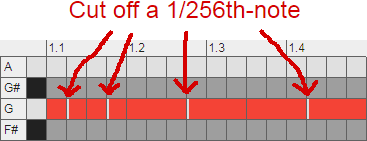
The bigger the amount we shorten a note and play the note delayed by the same amount we shortened it, the more obvious the added swing (if it still is a swing) becomes. I like to use a 256th-note for such an amount in EDM since I can notice it consciously and unconsciously. Also, for me, a 128th-note amount is too much, and a 512th-note amount is too hard to notice.
When To Add Swing to a Music Note Rhythm
As far as I know, we should probably not add swing to every music note rhythm in an EDM song. In my opinion, the advantage of using swing is to give a rhythm something extra that not all song elements have so that the elements with an added swing can stand out from the other elements.
As a guideline, I give swing to a maximum of two percussion rhythms and two music note rhythms. However, I try to use only two rhythms with swing, one percussion rhythm, and one music note rhythm.
Giving Space to Music Notes in a Rhythm
We can make music note rhythms with multiple notes directly after each other without rests, which can sound nice. However, we might improve such rhythms by shortening the notes a small amount at the end that have directly another note after them, which I see as letting the notes breathe. I like to shorten them by a 256th-note amount since I think a 128th-note amount is too much, and a 512th-note amount is too hard to notice.
For example, we have a music note rhythm with four 8th-notes directly after each other. Then we can shorten the first three notes of those at the end by a 256th-note.
Dada Life mentions similar shortening of music notes in the YouTube video “Dada Life In The Studio programming basslines.”
Closing Words
Hopefully, you have learned something from this music note rhythm tutorial.
If you like this post, look at some other posts on this website since you might also like them.
When you know someone who likes to learn more about music note rhythms, you can share this post.

